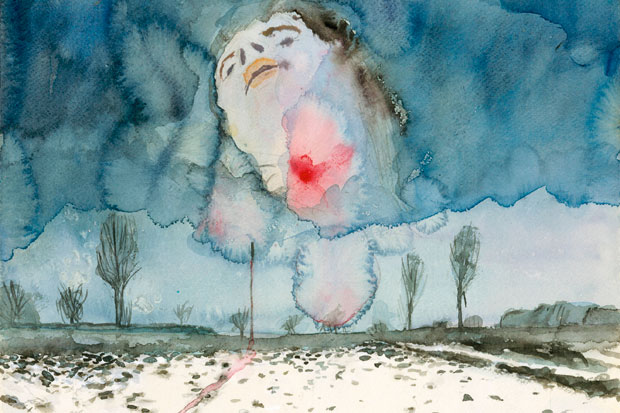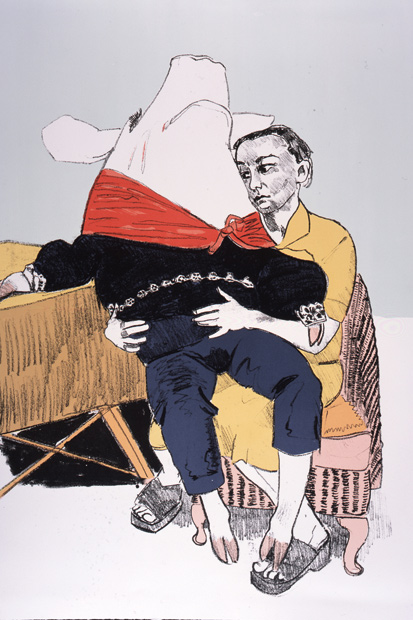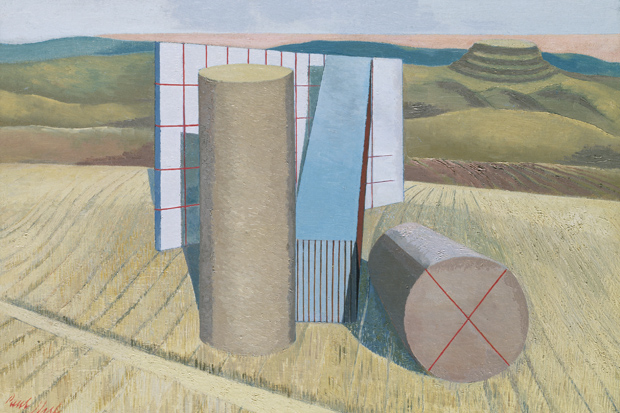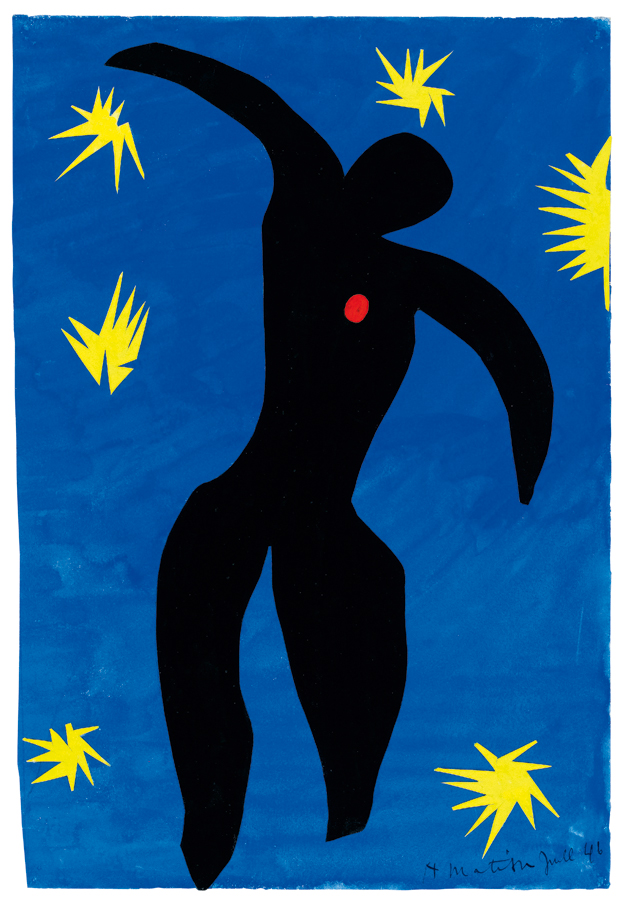In the Royal Academy’s courtyard are two large glass cases or vitrines containing model submarines. In one the sea has receded, dried up, and the tin fish are stranded on the cracked mud of the ocean floor. In the other, the elegantly rusted subs are mostly suspended like sharks in an aquarium: a fleet in fact, all pointed in the same direction.
These works are the visitor’s first sight of the vast and glorious exhibition by Anselm Kiefer (born Germany, 1945) currently occupying the main galleries of Burlington House, and they are apparently related to his interest in the Russian poet and futurist Velimir Khlebnikov. At once we are confronted by several Kiefer themes: war, poetry (he says poems are ‘like buoys in the sea. I swim to them, from one to the next …without them, I am lost’), and Mesopotamian clay tablets. His very particular mix of history, imaginative transformation and high culture is thus succinctly introduced.
There have been plenty of opportunities to see Kiefer’s work in Britain in recent decades (I well remember an impressive show of giant lead books at Riverside Studios in Hammersmith in 1989), but I must admit that up to now I have remained equivocal about him. The Academy’s show has completely changed my mind. I have never seen Kiefer better presented, and in this exhibition his imagery and use of materials make perfect sense. The increasingly large works have been superbly laid out through the grand galleries, and their cumulative effect is not so much overwhelming as utterly convincing. This remarkable display makes a great argument for the monographic exhibition. Not all artists can survive this sort of exposure, some looking too repetitious or threadbare in extensive solo shows, but Kiefer’s work thrives on it, and the exhibition is a triumph.
The first couple of rooms offer a kind of prologue of early work, introducing Kiefer’s abiding passion (since 1968) for artists’ books, his drawings and watercolours, and the wood-grain ‘Attic’ series of the 1970s. The exhibition really catches fire in room 3 with the increased scale and texture of the paintings, the inventive use of materials (clay, ash, earth, straw, dried sunflowers, scorched photos) and a certain salutary grimness of subject. Here the aggrandising tendency of Nazi architecture is squarely faced, the neoclassical stone structures built to last (and make fine ruins), as against the bricks of straw and the writing on the wall of the artist’s alternative reality. If some of the paintings look like dried-up river beds, suggesting drought and starvation, this is the other side to handsome prisons of the spirit.
Kiefer uses the shape of a palette in his pictures to stand for himself, and I was reminded of Leonard Cohen’s lyric ‘like a bird on the wire/ Like a drunk in a midnight choir’ when looking at ‘Palette on a Rope’ in room 4, though there’s more than one bird on this particular wire, and they look decidedly flame-like. Room 5 contains just two enormous paintings: ‘Osiris and Isis’ on one side, decked out with copper wire and what looks like the fragments of a washbasin; ‘For Ingeborg Bachmann: The Sand from the Urns’ is on the other, an achingly beautiful, desiccated landscape. The theme is death and resurrection, just one of the great linked polarities that Kiefer rarely shrinks from addressing.
Burnt books, branches, roses — all are incorporated in one or other of the epic paintings on display here, many of which, despite their size, come from private collections. Kiefer has a genuine interest in the mystic life, and is as likely to explore the diamond-studded firmament as he is the fertile plain. In room 11, we find Kiefer in agrarian mode, evoking ‘a land, perpetually coming to harvest’ (Ronald Johnson: The Book of the Green Man). These intensely romantic images of fruitfulness are subverted by such things as a mantrap attached to the painting’s surface — a notable vagina dentata clearly echoing Courbet’s ‘L’Origine du Monde’ — old shoes or a set of primitive scales, along with volcanic stone and gold leaf. Since the death of the Catalan master Antoni Tàpies, Kiefer must be our leading artist-magus.
Some people complain that they’re overburdened by the weight of reference in Kiefer’s paintings, the history, poetry and philosophy that inform his approach. I can only say that the viewer does not need to know or recognise its presence, nor feel inadequate before Kiefer’s learning. There is much to enjoy in his work on a purely formal level, but if you wish to explore the manifold layers of meaning below the surface, there’s even more to intrigue and savour. Then there are those who think his pictures rather rudimentary, exploiting texture and simple perspective and owing more to the mud and muck of the farmyard than to any alchemical (or artistic) transformation.
Others admire his work but regret the industrial scale on which it now seems exclusively to operate, and suggest that you can get away with murder with an adoring international market and an army of assistants. But I have to say that such quibbles dwindle and vanish in the face of this beautifully installed exhibition. It is the art that has to convince us or condemn itself, and this is a breathtaking show, a real source of awe and wonder, probably the most astonishing event of the season.
And it can be a pretty silly season too, as demonstrated by the media circus which is now the annual Turner Prize. When the prize was founded in 1984, it seemed to offer some hope of promoting excellence with such artists as Malcolm Morley and Richard Deacon winning in early years. But since the millennium, it has increasingly become the resort of installation and multimedia artists, not painters and sculptors, and this colonisation has resulted in a tragic loss of credibility. The new conceptual orthodoxy is nothing more than a current establishment fashion but its perpetrators and propagators seem bent on excluding more traditional forms of art.
The problem is that the so-called experimental art showcased by the Turner Prize is so thoroughly passé that it merely recycles ideas thought new and original half-a-century ago. But the pundits of the media still find such stale stuff wonderfully controversial and diverting. To my mind, the unholy crop of films, wallpaper, slide projections, bad writing, flags, sociological reportage and relentless pretension that makes up this year’s shortlist is intensely depressing. The banality is unredeemed. Time to abolish the Turner Prize and inaugurate a Constable Prize for Painting, and perhaps a Henry Moore Prize for Sculpture.
Got something to add? Join the discussion and comment below.
Get 10 issues for just $10
Subscribe to The Spectator Australia today for the next 10 magazine issues, plus full online access, for just $10.
You might disagree with half of it, but you’ll enjoy reading all of it. Try your first month for free, then just $2 a week for the remainder of your first year.














Comments
Don't miss out
Join the conversation with other Spectator Australia readers. Subscribe to leave a comment.
SUBSCRIBEAlready a subscriber? Log in